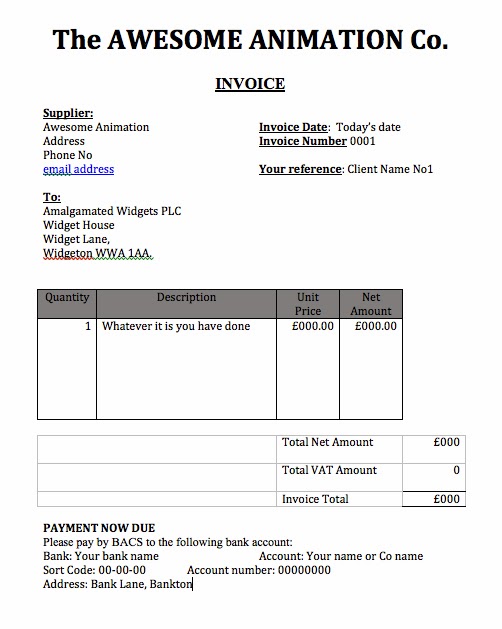I remember the first time I did a freelance job for an independent production co, back in the late 1980s. The job was a breakfast cereal commercial for Passion Pictures. Today, Passion is one of London's leading independent film-makers, then it was a fledgling start-up in Soho. I was very inexperienced, trying not to show it.
Andrew Ruhemann, who founded Passion, asked me to prepare an invoice for the work I had done. An invoice? What was that? I had no idea what one even looked like. Too embarrassed to ask (I was doing my best to look like a pro), I ended up producing a hand written bill on a scrap of paper that would have put a plumber to shame.
You can and will do better. At the top of the blog is a sample invoice, taken from Wikipedia. It includes all the vital information that should be on an invoice. This will include:
- A heading at the top, saying "Invoice"
- Your name, your own brand, or your company name (if you have a company). If you don't have a company, you can put your own name or simply a trading name, which can be anything. "Awesome Animation", "Garage Films" - or whatever. A trading name is just that - the name you trade under.
- Invoice Number. These should be sequential. Begin at number 1 and start counting.
- Today's date.
- Your terms. These are usually "payment due within 14 days" or thereabouts.
- Supplier name and address - that's you, the supplier of services
- Client name and address - that's the person or company you are invoicing.
- Description. This is a description of the services you have done. Be as specific as you can.
- Amount owed. This is the price for the job. This should be agreed with the client in advance. Clients don't like nasty surprises. You won't need to charge VAT yet (unless you turn over more than £75,000 a year) so you can leave that at zero.
- Your bank details. Without this you won't get paid.

Always make sure you double-check every invoice before you send it out. Nothing is more embarrassing than getting it wrong - and clients will not appreciate it.
Which leads us to the last important question: how long should you wait for payment before chasing up your invoice? The answer is: not less than 4 weeks. Chasing clients after a few days or even a week or two is bad manners, whatever the payment terms on your invoice. Most companies tend to do their accounts once a month, so anything less than that and you will simply be outside the payment cycle. Generally, for bigger companies, you will have to wait longer. Be patient! Everyone pays in the end. Apart from criminals of course - and why would you do business with them?
(Editor's Note: For more information on working as a freelancer, check out our recent post on Portfolio Careers. For advice on careers, check out our guide to animation careers here. For more on what studios look for in a great demo reel, try this link, hear what London's Blue Zoo has to say about finding work, and take a look at this video by Sony Pictures Animation. You can also watch Alex's ten minute video on creating a great reel, and read this post on the perfect demo reel. Also, check out our guide to animation careers here, and also take a look at this map of digital studios - a great place to start your search for work in the business. And don't forget to read our guide to putting together a great CV.)



As someone just starting out and pretty clueless, THANK YOU FOR THIS.
ReplyDelete